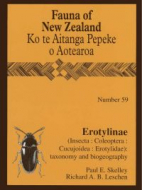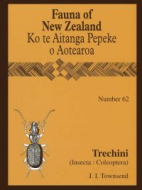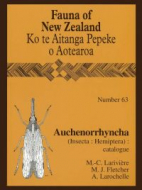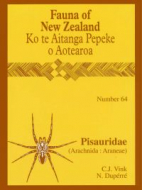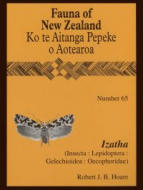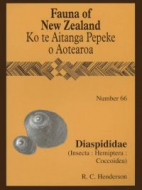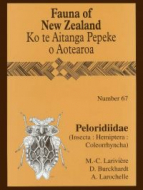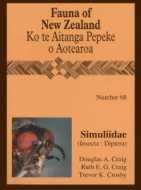|
|
Fauna of New Zealand 59 : Erotylinae
ISBN: 9780478093919
Author:
Paul Skelly
Publisher: Manaaki Whenua Press
Erotylinae are also known commonly as the ‘pleasing fungus beetles’ for their often striking colours, though these do not occur in New Zealand species. The ...
Erotylinae are also known commonly as the ‘pleasing fungus beetles’ for their often striking colours, though these do not occur in New Zealand species. The 8 New Zealand erotyline species comprise a relatively small group, considering that nearby Australia has 50 species.
Erotylinae are represented in New Zealand by two genera, one of which is endemic. Various authors have described erotyline species, or created lists for them, but none has attempted to evaluate these taxa and update their taxonomy.
In Fauna of New Zealand 47, Rich Leschen restructured the family Erotylidae to include the family Languriidae, and examined the status of the higher taxa based on a cladistic analysis of adult characters. He also reviewed the New Zealand species that would have been included in the former family Languriidae. The purpose of this paper is to complement Leschen’s review of New Zealand’s Erotylidae by covering the species of subfamily Erotylinae.
In this Fauna, the fungus-feeding Erotylinae fauna of New Zealand are revised and a key to the adults and illustrations of key characters for all species are presented.
Bind: paperback
Pages: 60
Publication Date: 04-03-2014
|
$30.00
|
|
|
How to put Nature into our Neighbourhoods
ISBN: 9780478093971
Author:
Maria Ignatieva
Publisher: Manaaki Whenua Press
Low Impact Urban Design and Development (LIUDD) is a sustainable living concept. Urban sustainability and health are achieved through effective management of st...
Low Impact Urban Design and Development (LIUDD) is a sustainable living concept. Urban sustainability and health are achieved through effective management of stormwater, waste, energy, transport and ecosystem services. The greening of cities by planting ecologically with local species is also a vital part of the overall well-being of ecosystems and citizens. Biodiversity or nature heritage contributes to enduring sense of place or identity - a key element of nationhood.
This manual is for the town dweller, developer, landscape designer and planner - and provides practical applications from nearly a decade of LIUDD research across New Zealand. It summarises and links to information regarding the physical and built environment, but its focal point is nature heritage and overcoming attrition and critical loss.
Bind: paperback
Pages: 52
Publication Date: 04-03-2014
|
$34.99
|
|
|
Fauna of New Zealand 62 : Trechini
ISBN: 9780478347159
Author:
J Ian Townsend
Publisher: Manaaki Whenua Press
Trechini beetles
Trechini are small- to medium-sized ground beetles that require high humidity. Almost half the known New Zealand trech...
Trechini beetles
Trechini are small- to medium-sized ground beetles that require high humidity. Almost half the known New Zealand trechine species are found in caves, which provide an environment close to 100% humidity, and these are highly modified for an underground life. Insects that are restricted to caves have had an interesting history as they have had to cope with major geological changes to the landscape over the last few million years. Surface-dwelling species also require high humidity and are usually found along streamsides or in beach gravel below the high water mark.
There are about 2500 species in the tribe Trechini worldwide. Currently there are 33 species of trechines known from New Zealand, all of which are endemic except one. Amongst New Zealand’s relatively few species are some lineages that are apparently not present in Australia, Tasmania, or South America, giving rise to some interesting biogeographic questions.
Although the number of New Zealand’s trechine species is small on a world scale, they are a special part of our biota because they are one of our most diverse groups of cave insects, they occupy unusual habitats, and they show extreme adaptations to the hostile environments in which they live.
In this Fauna New Zealand Carabidae of the tribe Trechini are revised and relationships to the world fauna are discussed. Their survival during changing geological episodes is discussed.
Bind: paperback
Pages: 101
Publication Date: 04-03-2014
|
$49.50
|
|
|
Environmental markets for New Zealand : the barriers and opportunities
ISBN: 9780478347800
Author:
Suzie Greenhalgh
Publisher: Manaaki Whenua Press
Environmental markets are one option in an array of interventions available to policymakers for reducing environmental degradation or improving environmental qu...
Environmental markets are one option in an array of interventions available to policymakers for reducing environmental degradation or improving environmental quality. While markets are not always an appropriate policy response, they are often promoted as a more palatable and cost-effective option for achieving an environmental goal than stand-alone regulation, especially by those regulated. This is because markets can allow greater flexibility to those causing environmental harm in how they meet their regulatory obligations – which may result in cost-savings.
Environmental markets first emerged in the 1970s and have become much more prominent internationally since the mid-1990s. A large number of markets now exist worldwide for a wide range of environmental commodities including water quality, water quantity, carbon, sulphurous and nitrous gases, fish stocks, wetlands, and threatened species. This growing international experience provides a basis for assessing whether, and in what circumstances, environmental markets are truly successful, and what is needed to establish a successful environmental market.
In this Science Series report, the authors ask what is required to establish successful environmental markets in general, and investigate some of the barriers to the development of such markets in New Zealand. They identify some actions that could facilitate the evolution of successful environmental markets for New Zealand, focusing primarily focus on compliance markets, in particular those for greenhouse gases, water quality, water quantity and biodiversity.
Bind: paperback
Pages: 45
Publication Date: 04-03-2014
|
$30.00
|
|
|
Fauna of New Zealand 63 : Auchenorryhncha
ISBN: 9780478347203
Author:
M-C Larivière
Publisher: Manaaki Whenua Press
This is a biosystematics catalogue for the Auchenorrhyncha, generally regarded as a suborder of the Hemiptera. They include planthoppers, cicadas, froghoppers, ...
This is a biosystematics catalogue for the Auchenorrhyncha, generally regarded as a suborder of the Hemiptera. They include planthoppers, cicadas, froghoppers, spittlebugs, treehoppers, and leafhoppers.
These insects are highly diverse and form a major component of the plant-feeding fauna of most terrestrial ecosystems. Auchenorrhyncha have adopted varied life habits on nearly all continents and islands and there may be around 42 000 species described worldwide. Compared with larger regions the New Zealand fauna – currently comprising 12 families, 68 genera and 196 species – may appear relatively small but what it lacks in size it makes up for in uniqueness, e.g., 82% of known species do not occur anywhere else in the world. From this point of view New Zealand can be regarded as a biodiversity “hot spot” for this group of insects. New genera and species will be discovered in the future and once fully described the New Zealand fauna may reach 300 to 350 species.
In this volume, crucial questions about Auchenorrhyncha are posed and answered: which species occur in New Zealand, what is their status? What are the resources available to identify and study them? Where do species and genera occur ? When are they active? How do they live? To answer these questions this catalogue brings together the available literature and collection-based information on extant taxa recorded from New Zealand’s main islands and its offshore islands.
The catalogue has been written with the needs of biosystematists, identifiers, biosecurity and conservation managers, ecologists, other biologists, and members of the public in mind, hence the sections summarising for all species the geographic distribution, biology, dispersal power, and reference to available identification tools, taxonomic revisions, and natural history treatments. A species checklist, full bibliography, taxonomic index, eight appendices, species distribution maps, and primary type colour photographs are also provided.
Bind: paperback
Pages: 232
Publication Date: 04-03-2014
|
$75.00
|
|
|
Fauna of New Zealand 64 : Pisauridae
ISBN: 9780478347227
Author:
C Vink
Publisher: Manaaki Whenua Press
Nurseryweb spiders
Four closely related species of Pisauridae (nurseryweb spiders) are found in New Zealand; three on the mainland and ...
Nurseryweb spiders
Four closely related species of Pisauridae (nurseryweb spiders) are found in New Zealand; three on the mainland and one on the Chatham Islands. All species are endemic to New Zealand and are likely to be related to Australian species. The most common species is Dolomedes minor, found throughout New Zealand in scrubland, grassland, swamps and marshes. Dolomedes aquaticus is found in open riverbeds and stony lakeshores throughout the South Island and in the southern half of the North Island. A new species of Dolomedes is found in shaded riverbeds throughout the mainland. The Chatham Island species, Dolomedes schauinslandi, is nationally endangered due to its restricted range.
In this Fauna the genus Dolomedes and all New Zealand species are described, with information on synonymy, type data, material examined, and geographical distribution. Habitus images of adults, illustrations of important structural features, and distribution maps are provided. A key to adults is given. A molecular phylogenetic analysis examining the relationships of New Zealand species in the genus is presented.
Bind: paperback
Pages: 60
Publication Date: 04-03-2014
|
$37.50
|
|
|
Fauna of New Zealand 65 : Izatha
ISBN: 9780478347241
Author:
Robert Hoare
Publisher: Manaaki Whenua Press
Lichen Tuft Moths
The genus Izatha only occurs in New Zealand. It is one of our special and diverse groups of endemic moths, with 40 sp...
Lichen Tuft Moths
The genus Izatha only occurs in New Zealand. It is one of our special and diverse groups of endemic moths, with 40 species now recognized. Most of them are beautifully camouflaged when resting on the trunks of our forest trees so that they resemble bark or lichen, and they have been popularly named ‘lichen tuft moths’ as a result. Some Izatha species are apparently rare and may be in need of special conservation.
Caterpillars of Izatha almost all tunnel in dead wood, where they probably digest the fungal element; others appear to feed on bracket fungi or lichens. Izatha species thus play an essential role as decomposers, responsible for recycling the nutrients in New Zealand’s forests and shrublands.
Despite their interesting form and ecological significance, the study of these moths has been neglected and 15 new species are described in this volume, which represents an increase of 60% over the 25 previously known.
This Fauna covers the classification, distribution, ecology and biology of Izatha. It includes information about new species, keys, sexual selection and sexual antagonism. The adults of all species are described and illustrated in colour.
Pages: 201
Publication Date: 04-03-2014
|
$75.00
|
|
|
Fauna of New Zealand 66 : Diaspididae
ISBN: 9780478347265
Author:
R Henderson
Publisher: Manaaki Whenua Press
The armoured scale insect family Diaspididae is one of ten families of plant-sucking scale insects present in New Zealand, and this family has three unique feat...
The armoured scale insect family Diaspididae is one of ten families of plant-sucking scale insects present in New Zealand, and this family has three unique features. The first feature is that the stomach of armoured scale insects is not directly connected to the hind gut, so they do not produce honeydew; the second is their armour or scale cover, in which they incorporate the cast skins of their juvenile moults; and the third feature is the fused segments of the posterior part of the abdomen called the pygidium.
In this Fauna the adult females of all 49 species of Diaspididae known from New Zealand, except the Leucaspidini, are described and illustrated. Four new genera and seven new species are described, and nomenclatural changes are noted. The 1st- and 2nd-instar nymphs of all the endemic species and of four Australian species that are of systematic interest are also described and illustrated. Keys to allow separation of adult females of all genera and species are included.
Additional features of this Fauna include: a brief review of earlier work on the Diaspididae in New Zealand; discussion of the biology and life cycle, scale cover formation, natural enemies, distribution, host plant associations including galls, and economic importance; a guide to methods for slide-mounting Diaspididae as used in the NZ Arthropod Collection.
Bind: paperback
Pages: 275
Publication Date: 04-03-2014
|
$89.00
|
|
|
Fauna of New Zealand 67 : Peloridiidae
ISBN: 9780478347302
Author:
M-C Larivière
Publisher: Manaaki Whenua Press
The family Peloridiidae or moss bugs are primitive members of the insect order Hemiptera. Often called ‘living fossils’, peloridiids belong to the suborder ...
The family Peloridiidae or moss bugs are primitive members of the insect order Hemiptera. Often called ‘living fossils’, peloridiids belong to the suborder Coleorrhyncha and live in the wet moss of temperate and subantarctic rainforests. Seventeen genera and 36 species are known from Chile, Argentina, New Zealand, New Caledonia, and eastern Australia.
New Zealand can be regarded as a biodiversity ‘hotspot’ for these insects: the three genera and 13 New Zealand species are endemic, meaning they do not occur anywhere else. New Zealand has the most diversified fauna at the species level, with 36% of all world species in this group of special significance for the Southern Hemisphere, with evolutionary roots dating back to the break-up of Gondwana. Moss bugs have hardened forewings and all New Zealand species lack hind wings, so are flightless, which makes them an ideal model group to test Gondwanan biogeographic hypotheses.
This Fauna offers a concise review of this ‘iconic’ Gondwanan group, reconciling results published by Burckhardt (2009) and Burckhardt et al. (2011) with a study of specimens contained in New Zealand entomological collections and museums. This faunal review aims to provide an inventory of New Zealand taxa, a concise treatment of their taxonomy, identification keys to genera and species, and a summary of information available on species distribution and biology.
Bind: paperback
Pages: 78
Publication Date: 04-03-2014
|
$48.00
|
|
|
Fauna of New Zealand 68 : Simuliidae
ISBN: 9780478347340
Author:
Douglas Craig
Publisher: Manaaki Whenua Press
Black flies, sandflies, te namu
Known in New Zealand as ‘sandflies’ or ‘te namu’ and elsewhere in the world mainly as ‘black ...
Black flies, sandflies, te namu
Known in New Zealand as ‘sandflies’ or ‘te namu’ and elsewhere in the world mainly as ‘black flies’, Simuliidae are iconic New Zealand insects. Virtually every New Zealander has been bitten by female simuliids, as have many overseas tourists. Worldwide, simuliids are notorious for their disease transmission, in particular river blindness in Africa and South America. New Zealand simuliids are not known to transmit any diseases to humans, but many people react badly to bites of species to which they have no previous exposure.
Simuliids of New Zealand belong to the genus Austrosimulium known only from New Zealand, Tasmania, and mainland Australia. Simuliid larvae require running water and in New Zealand are more or less ubiquitous, occurring in almost all running water habitats. There are 19 species of Austrosimulium in New Zealand, but only three species found here are serious biters of humans and it is only the females that bite; they bite to get the nutrients to produce eggs. In this Fauna keys are provided for larvae, pupae, adults, and ecological habitats. All known stages are described and illustrated for each species, together with information on their bionomics and biogeography. There are 72 full page colour plates and a total of 540 figures. Molecular analysis indicated that New Zealand Austrosimulium arrived by dispersal about 5 million years ago.
Elsewhere in the world simuliids in the genus Austrosimulium may be considered to feed on birds or mammals, depending on the presence or absence of a tooth on the tarsal claw. New Zealand simuliids are opportunistic and females will generally take blood meals from whatever is available, though there is one species that attacks Fiordland crested penguins while studiously avoiding humans.
What did New Zealand simuliids feed on before humans arrived? Of little doubt it would be on the vast number of birds, now greatly depleted, and probably also the large numbers of seals present then. Indeed, searching along beaches for a blood meal from either birds or seals still appears inherent behaviour of New Zealand adult female simuliids — and probably the reason for their name ‘sandflies’.
Bind: paperback
Pages: 336
Publication Date: 04-03-2014
|
$95.00
|



